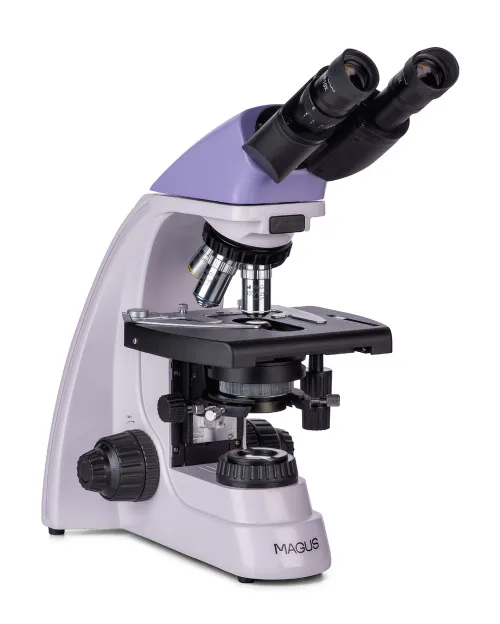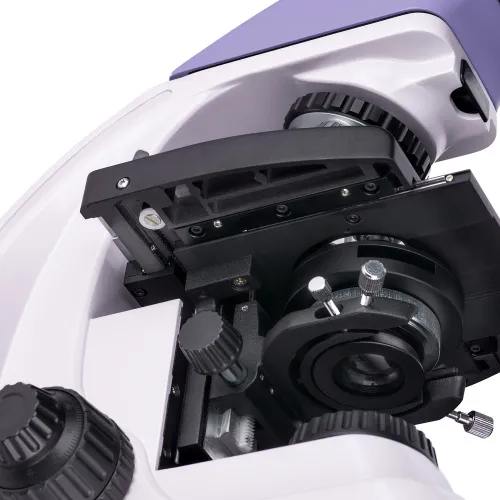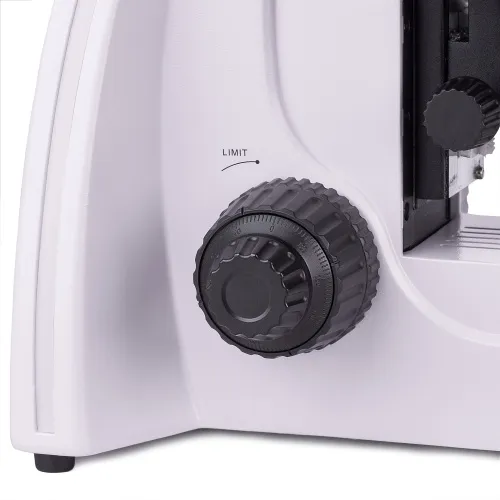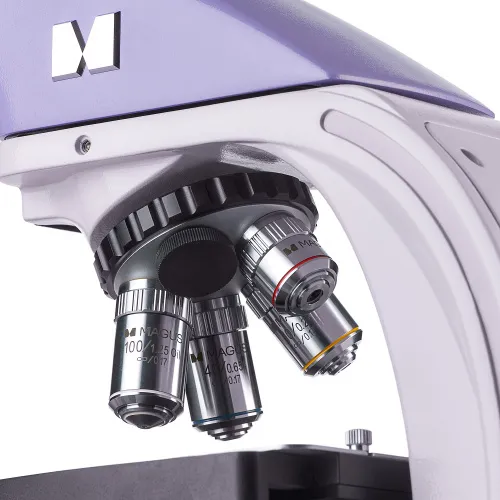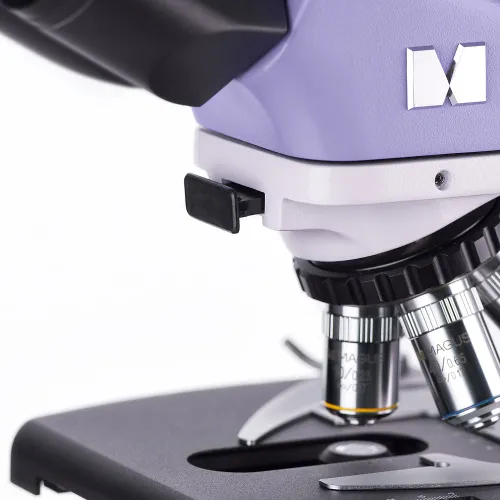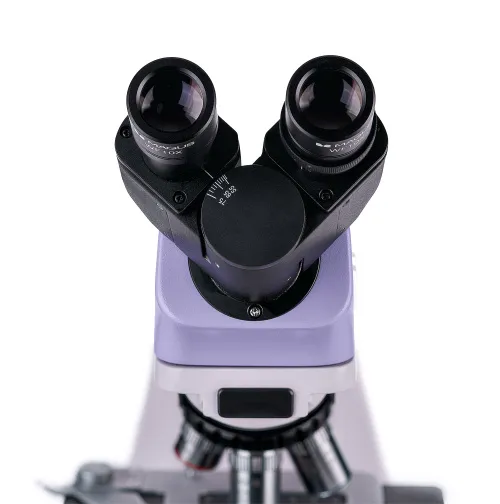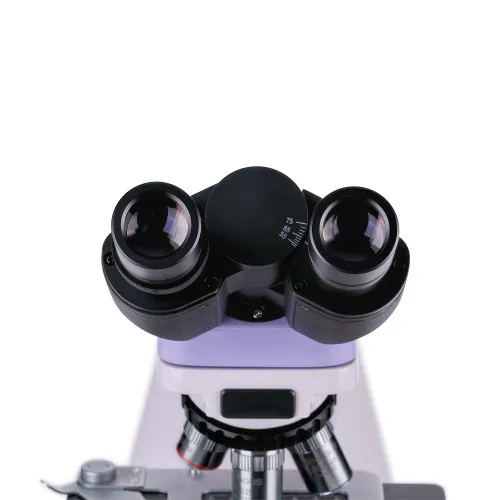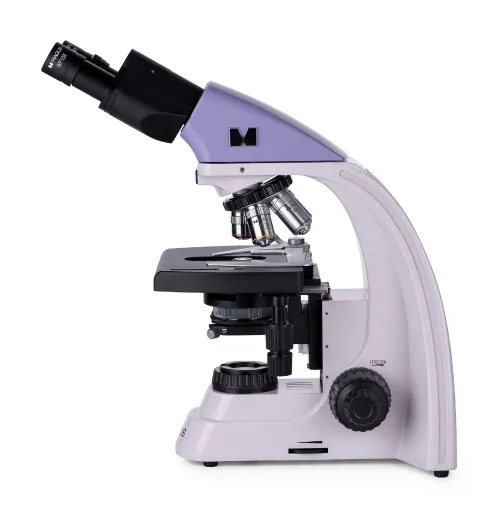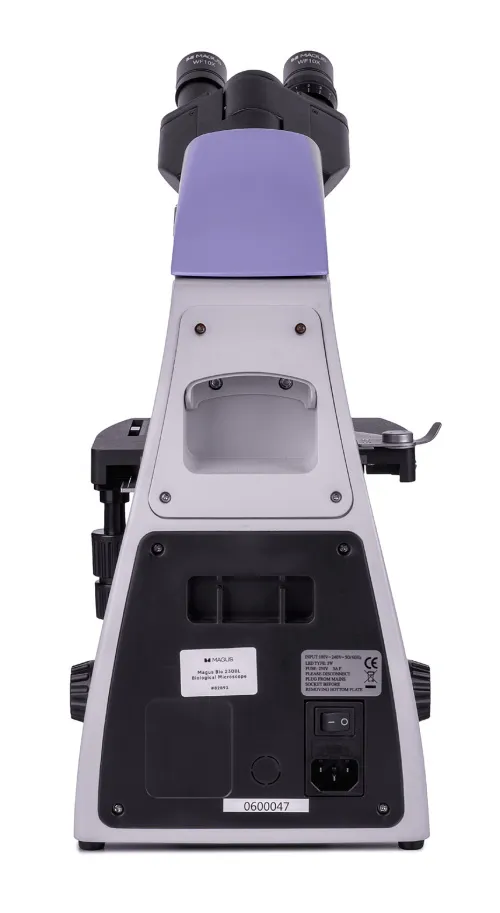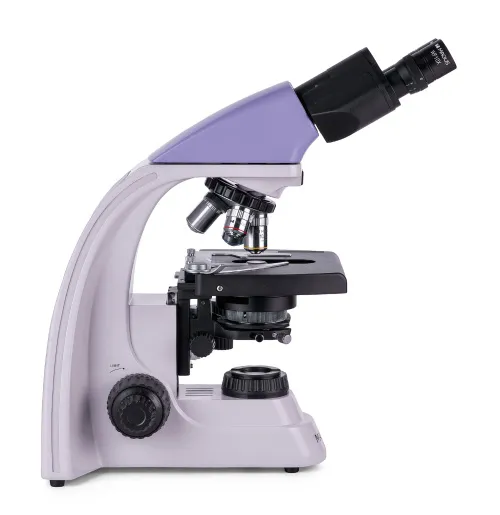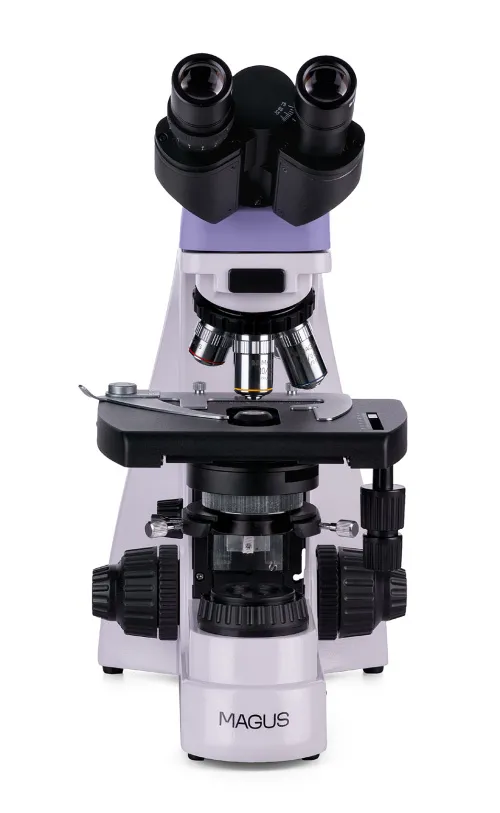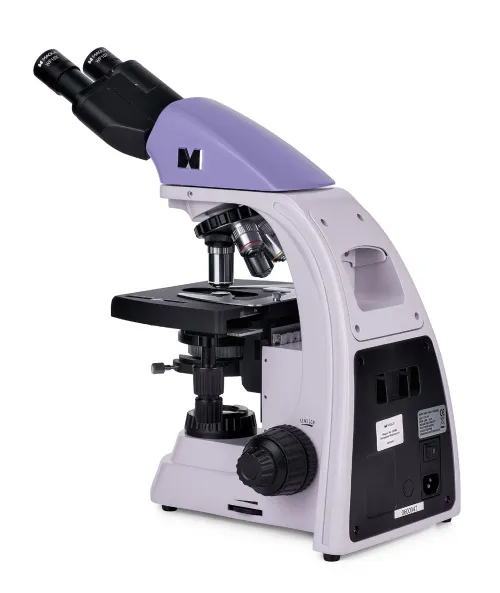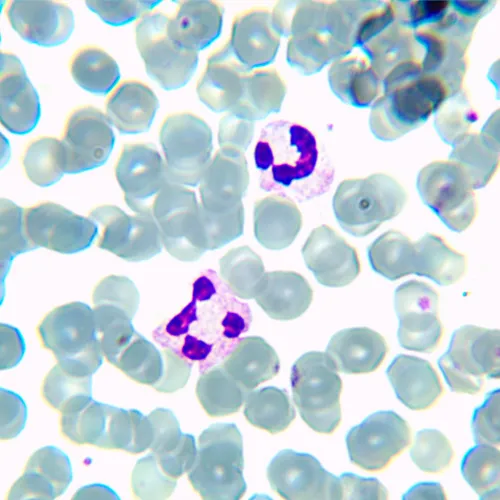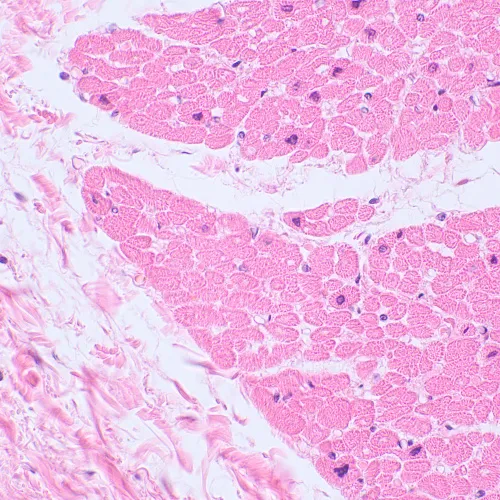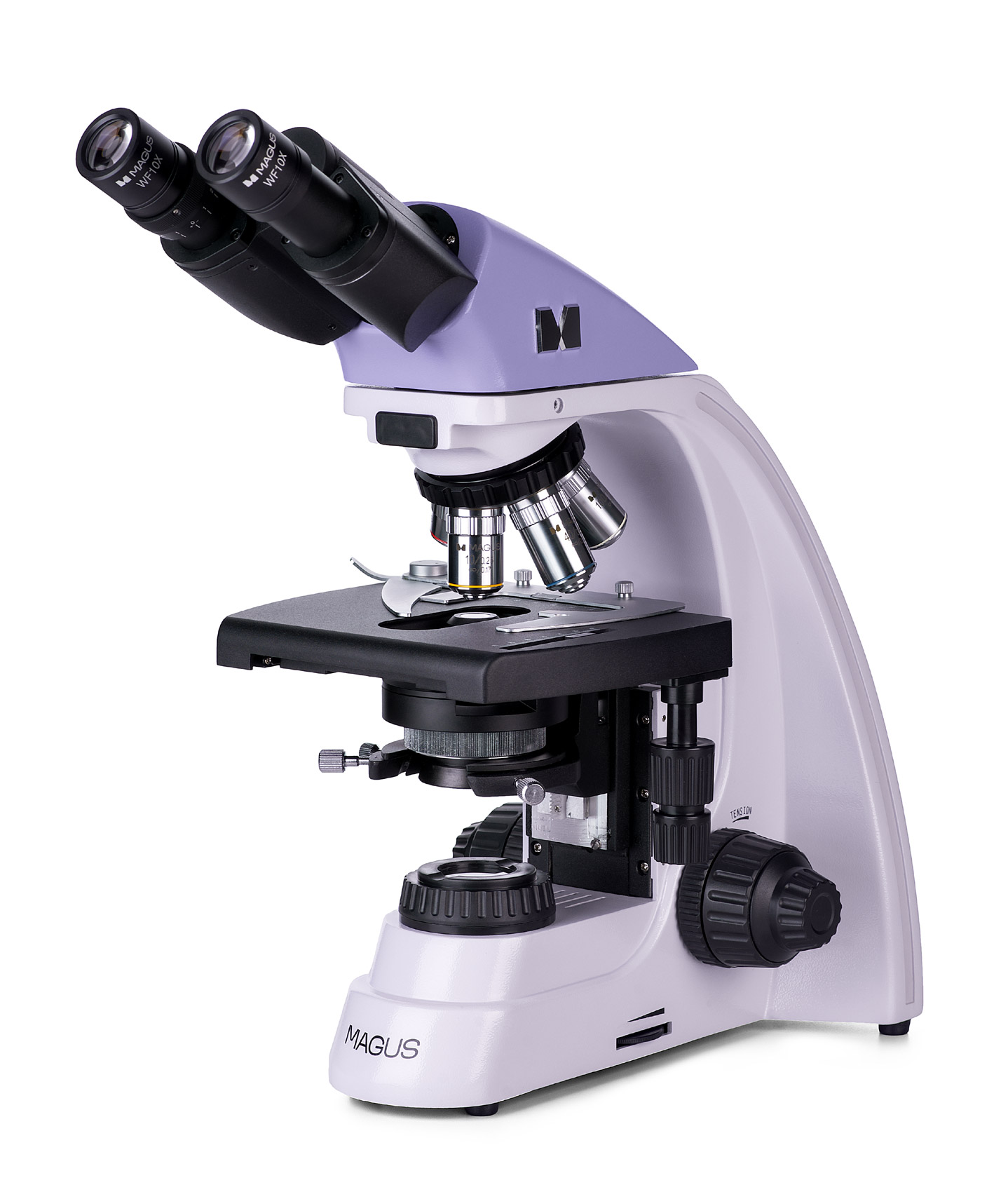MAGUS Bio 230BL Biological Microscope
Magnification: 40–1000x. Binocular head, achromatic objectives, 3W LED
| Product ID | 82893 |
| Brand | MAGUS |
| Warranty | 5 years |
| EAN | 5905555017969 |
| Package size (LxWxH) | 43x27x63 cm |
| Shipping Weight | 10 kg |
MAGUS Bio 230BL is a binocular microscope with achromatic objectives and LED illumination for observing biological samples such as smears and thin sections. The observations are made with the transmitted light microscopy technique (brightfield). The microscope can be equipped with optional darkfield, polarized light, and phase contrast devices. Areas of application: pharmaceuticals, medicine, biotechnology, veterinary medicine, forensics, agriculture, etc.
Optics
The observational tubes rotate 360°, which allows you to adjust the eyepieces to fit the height of the observer. There is a diopter adjustment ring on the left tube. A digital camera (purchased separately) can be mounted into the same tube.
Since the revolving nosepiece has 5 slots, another objective can be attached in addition to the supplied objectives in order to achieve higher magnification over the possible magnification range. The basic microscope magnification ranges from 40 to 1000x, the upper limit may be increased up to 1500, 1600, or 2000x by adding additional eyepieces. The optics of the microscope are infinity-corrected. The revolving nosepiece is oriented toward the interior.
Illumination
The transmitted light source is a 3W LED powered by AC power supply. By adjusting the illumination brightness, the color temperature remains the same, and the LED has a lifespan of 50,000 hours.
The illumination is controlled by adjusting the aperture and field diaphragms, i.e., there is an option to set up the Köhler illumination. The Abbe condenser is height-adjustable and can be centered. There is an option to insert a dark field slider or phase contrast slider into a slot in the condenser. The sliders make it easier for the user to switch from one microscopy technique to another.
Stage and focusing mechanism
You can move the object of study across the stage with the mechanical attachment, which can be removed if necessary. The stage does not have a positioning rack, and so the mechanical part occupies less space.
Focusing is controlled by moving coarse and fine focusing knobs. These knobs are on the same axis (coaxial) on each side of the microscope. Located at the base, they are convenient to rotate with your hands without any effort. The coarse focusing has a lock knob and tension adjustment. The rotation of the knob is smooth and easy.
Accessories
Additional accessories for MAGUS Bio 230BL microscope: dark field condensers, polarization devices, digital cameras, calibration slides, eyepieces, objectives, phase contrast devices, etc.
Key features:
- Infinity achromatic objectives, revolving nosepiece with 5 slots
- Binocular head with diopter adjustment on the left tube
- The eyepiece adjustment by the 360° eyepiece rotation
- 3W LED bulb with a lifespan of 50,000 hours
- Coarse and fine focusing knobs, coarse focusing tension adjusting knob, coarse focusing lock knob
- Field diaphragm, darkfield and phase contrast slider options (mounted in the condenser slot)
- Multiple optional accessories
The kit includes:
- Base with a power input, transmitted light source, focusing mechanism, stage, condenser mount, and revolving nosepiece
- Abbe condenser
- Binocular head
- Infinity achromatic objective: 4x/0.10
- Infinity achromatic objective: 10x/0.25
- Infinity achromatic objective: 40x/0.65 (spring-loaded)
- Infinity achromatic objective: 100x/1.25 oil (spring-loaded)
- Eyepiece 10x/18mm with a long eye relief (2 pcs.)
- Eyecup (2 pcs.)
- Filter (4 pcs.)
- Bottle of the immersion oil
- AC power cord
- Dust cover
- User manual and warranty card
Available on request:
- 10x/20mm eyepiece with a scale
- 15x/11mm eyepiece (2 pcs.)
- 16x/11mm eyepiece (2 pcs.)
- 20x/11mm eyepiece (2 pcs.)
- Infinity achromatic objective: 20x/0.40
- Infinity plan achromatic objective: 20х/0.40
- Infinity plan achromatic objective: 60x/0.80 (spring-loaded)
- Phase-contrast device
- Phase slider
- Darkfield condenser NA 0.9
- Oil darkfield condenser NA 1.36–1.25
- Darkfield slider
- Polarization devices
- Digital camera
- Calibration slide
- C-mount adapter
- LCD Monitor
| Product ID | 82893 |
| Brand | MAGUS |
| Warranty | 5 years |
| EAN | 5905555017969 |
| Package size (LxWxH) | 43x27x63 cm |
| Shipping Weight | 10 kg |
| Type | biological, light/optical |
| Microscope head type | binocular |
| Head | Gemel head (Siedentopf, 360° rotation) |
| Head inclination angle | 30 ° |
| Magnification, x | 40 — 1000 |
| Magnification, x (optional) | 40–1500/1600/2000 |
| Eyepiece tube diameter, mm | 23.2 |
| Eyepieces | 10х/18mm, eye relief: 10mm (*optional: 10х/20mm with a scale, 15x/11mm, 16x/11mm; 20x/11mm) |
| Objectives | infinity achromatic: 4x/0.10; 10x/0.25; 40xs/0.65; 100xs/1.25 (oil); parfocal distance 45mm (*optional: 20x/0.40; 60xs/0.80) |
| Revolving nosepiece | for 5 objectives |
| Working distance, mm | 18.89 (4x); 5.95 (10x); 0.775 (40xs); 0.36 (100xs); 2.61/8.80 (20x); 0.46 (60хs) |
| Interpupillary distance, mm | 48 — 75 |
| Stage, mm | 180x150 |
| Stage moving range, mm | 75/50 |
| Stage features | two-axis mechanical stage, without a positioning rack |
| Eyepiece diopter adjustment, diopters | ±5 (on the left tube) |
| Condenser | Abbe condenser, N.A. 1.25, center-adjustable, height-adjustable, adjustable aperture diaphragm, a slot for a darkfield slider and phase contrast slider, dovetail mount |
| Diaphragm | adjustable aperture diaphragm, adjustable iris field diaphragm |
| Focus | coaxial, coarse focusing (21mm, 39.8mm/circle, with a lock knob and tension adjusting knob) and fine focusing (0.002mm) |
| Illumination | LED |
| Brightness adjustment | ✓ |
| Power supply | 220±22V, 50Hz, AC network |
| Light source type | 3W LED |
| Light filters | yes |
| Operating temperature range, °C | 5...+35 |
| Ability to connect additional equipment | phase contrast device (condenser and objectives), darkfield condenser (dry or oil), polarization devices (polarizer and analyzer) |
| User level | experienced users, professionals |
| Assembly and installation difficulty level | complicated |
| Application | laboratory/medical |
| Illumination location | lower |
| Research method | bright field |
| Pouch/case/bag in set | dust cover |
| Weight, kg | 8 |
| Dimensions, mm | 200x436x400 |
We have gathered answers to the most frequently asked questions to help you sort things out
Find out why studying eyes under a microscope is entertaining; how insects’ and arachnids’ eyes differ and what the best way is to observe such an interesting specimen
Read this review to learn how to observe human hair, what different hair looks like under a microscope and what magnification is required for observations
Learn what a numerical aperture is and how to choose a suitable objective lens for your microscope here
Learn what a spider looks like under microscope, when the best time is to take photos of it, how to study it properly at magnification and more interesting facts about observing insects and arachnids
This review for beginner explorers of the micro world introduces you to the optical, illuminating and mechanical parts of a microscope and their functions
Short article about Paramecium caudatum - a microorganism that is interesting to observe through any microscope


